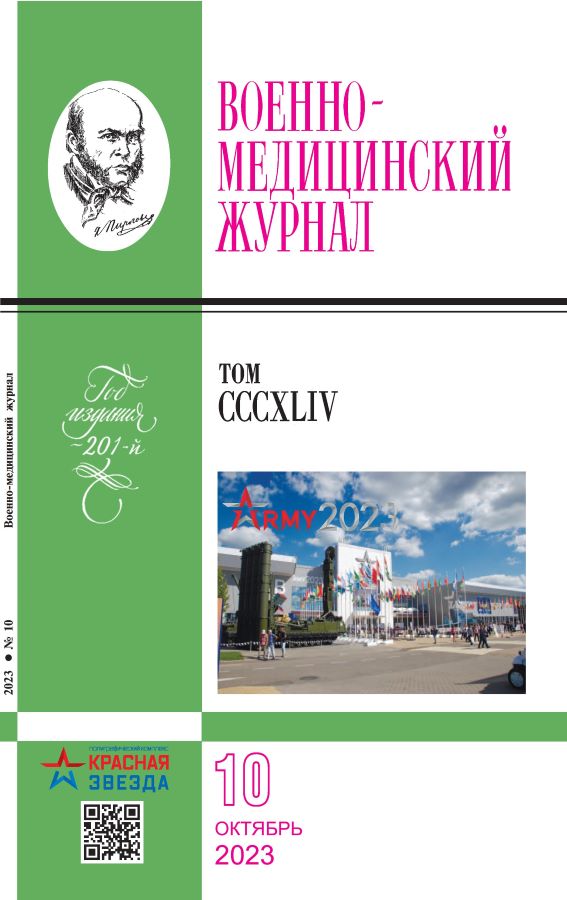Features of the organization of epidemiological surveillance in the armed forces of the foreign states
- Authors: Zobov A.E.1, Kuzin A.A.1, Yumanov A.P.1, Azarov I.I.2, Polyakov V.S.2, Pischugin D.Y.3
-
Affiliations:
- The S.M.Kirov Military Medical Academy of the Ministry of Defense of the Russian Federation
- Main Military Medical Directorate of the Ministry of Defense of the Russian Federation
- Main Center for State Sanitary and Epidemiological Surveillance of the Ministry of Defense of the Russian Federation
- Issue: Vol 344, No 10 (2023)
- Pages: 83-86
- Section: Brief articles
- URL: https://journals.eco-vector.com/0026-9050/article/view/630482
- DOI: https://doi.org/10.52424/00269050_2023_344_10_83
- ID: 630482
Cite item
Abstract
The article presents the results of the analysis of available literary sources covering the issues of epidemiological surveillance in the armed forces of a number of foreign states. It is shown that the features of its organization are due to the climatic and geographical characteristics of potential theaters of military operations, as well as socio-economic and military-political factors. Characteristics of differences in strategic approaches to epidemiological surveillance due to the influence of these factors are given.
Full Text
About the authors
A. E. Zobov
The S.M.Kirov Military Medical Academy of the Ministry of Defense of the Russian Federation
Author for correspondence.
Email: dr.andrey98@yandex.ru
Russian Federation, St. Petersburg
A. A. Kuzin
The S.M.Kirov Military Medical Academy of the Ministry of Defense of the Russian Federation
Email: dr.andrey98@yandex.ru
Russian Federation, St. Petersburg
A. P. Yumanov
The S.M.Kirov Military Medical Academy of the Ministry of Defense of the Russian Federation
Email: dr.andrey98@yandex.ru
Russian Federation, Moscow
I. I. Azarov
Main Military Medical Directorate of the Ministry of Defense of the Russian Federation
Email: dr.andrey98@yandex.ru
Russian Federation, Moscow
V. S. Polyakov
Main Military Medical Directorate of the Ministry of Defense of the Russian Federation
Email: dr.andrey98@yandex.ru
Russian Federation, Moscow
D. Yu. Pischugin
Main Center for State Sanitary and Epidemiological Surveillance of the Ministry of Defense of the Russian Federation
Email: dr.andrey98@yandex.ru
Russian Federation, Moscow
References
- Белов А.Б., Ишкильдин М.И., Кузин А.А., Зобов А.Е. Выдающийся военный эпидемиолог, ученый и педагог академик Виталий Дмитриевич Беляков // Воен.-мед. журн. – 2022. – Т. 343, № 1. – С. 72–80.
- Вильданов М.П. Основные положения доктрины ОВС НАТО «Медицинское обеспечение» // Зарубеж. воен. обозрение. – 2020. – № 12. – С. 22–29.
- Далматов В.В., Стасенко В.Л. Мониторинг, надзор и контроль в эпидемиологической деятельности // Инфекция и иммунитет. – 2012. – № 1–2. – С. 24–25.
- Симонова Е.Г. Современный этап развития эпидемиологического надзора и перспективы его совершенствования. // Эпидемиол. и вакцинопрофил. – 2017. – № 4 (95). – С. 4–8.
- Цвиркун О.В. Термины и определения. Всегда ли трудности перевода? // Эпидемиол. и вакцинопрофил. – 2022. – № 1. – С. 56–60.
- Amato-Gauci A., Ammon A. The surveillance of communicable diseases in the European Union – a long-term strategy (2008–2013). URL: https://www.eurosurveillance.org/images/dynamic/ (дата обращения: 24.07.2023).
- Army Regulation 40-5: Preventive Medicine.Washington, DC: US Dept of the Army; 22 July 2005. URL: http://milreg.com (дата обращения: 05.07.2023).
- Assistant secretary of defense-health affairs: Revised service guidelines for reportable medical events. – Washington, 2009. URL: https://pubmed.ncbi.nlm.nih.gov/10135126/ (дата обращения: 05.07.2023).
- Cao W.C., Chao F.H. Discipline progress of Chinese military preventive medicine // J. Prev. Med. Chin. PLA. – 2011. – Vol. 29, N 1. – P. 1–5.
- Communicable disease surveillance and response systems. Guide to monitoring and evaluating. Geneva: WHO. 2006. URL: https://apps.who.int/iris/handle/10665/69331 (дата обращения: 05.07.2023).
- DeFraites R.F. The Armed Forces Health Surveillance Center: enhancing the military health system’s public health capabilities. URL: https://bmcpublichealth.biomedcentral.com (дата обращения: 05.07.2023)
- Jeremy Sueker J., Blazes D.L., Johns M.C. et al. Influenza and respiratory disease surveillance: The US military’s global laboratory-based network // Influenza and other respir. viruses. – 2010. – Vol. 4, N 3. – P. 155–161.
- Fu X.B. Military medicine in China: old topic, new concept // Military med. res. – 2014. – N 1. – P. 1–5.
- Ho Z.J.M., Hwang Y.F.J., Lee J.M.V. Emerging and re-emerging infectious diseases: challenges and opportunities for militaries // Military med. res. – 2014. – N 1. – P. 21.
- Langmuir A.D. The surveillance of communicable diseases of national importance // N. Engl. J. Med. – 1966. – N 268. – P. 182–192.
- Michael B.G., Cates B. Prevention is the best way to health // Army Med. Depart. J. – 2006. – april–june. – P. 3–6.
- Mukanga D, Tshimanga M, Wurapa F. et al. The genesis and evolution of the african field epidemiology network // Pan. Afr. Med. J. – 2011. – N 10 (suppl. 1). – P. 2.
- Murray C.K., Horvath L.L., Ericsson Ch.D., Hatz Ch. An approach to prevention of infectious diseases during military deployments // Clin. infect. dis. – 2007. – Vol. 44, is. 3. – P. 424–430.
- Reddy C., Kuonza L., Ngobeni H. et al. South Africa field epidemiology training program: developing and building applied epidemiology capacity, 2007–2016 // BMC public health. – 2019. – Vol. 19. – Р. 3.
- Rubertone M.V., Brundage, J.F. The Defense medical surveillance system and the Department of defense serum repository: glimpses of the future of public health surveillance // Amer. J. of Public Health. – Vol. 92. – N 12. – P. 1900–1904.
- Soto G., Araujo-Castillo R.V., Neyra J. et al. Challenges in the implementation of an electronic surveillance system in a resource-limited setting: Alerta, in Peru // BMC. – 2008. – Proc. 2 (suppl 3). – Р. 4.
- Tan X.Q., Zhao X., Lee V.J. et al. Respiratory viral pathogens among Singapore military servicemen 2009–2012: epidemiology and clinical characteristics // BMC Infect Dis. – 2014. – N 14. – P. 204.
- The French Military influenza surveillance system (MISS): overview of epidemiological and virological results during four influenza seasons 2008–2012 // Swiss Med. Wkly. – 2013. – N 2. – P. 143.
- World Health Organization. National and global surveillance of communicable disease: Report of the technical discussions at the twenty-first World Health Assembly. – Geneva: WHO, 1968. – 15 p.
Supplementary files







